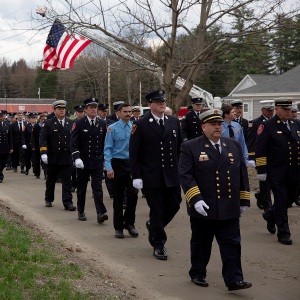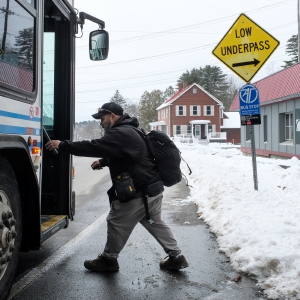Bridge Chemicals Drip on River; Swimmers Complain Drops Cause Burns
| Published: 07-11-2018 9:44 AM |
Royalton Village
The same summer heat that sent droves of people to the cooler, shaded area beneath the Bridge Street overpass last week also seems to have unleashed a torrent of black goo, Royalton Town Administrator Rose Hemond said.
“The river was just packed with people,” she said.
One such person was Tracy Borst, of Thetford, who was tubing with a group that included her husband, two adult children and a handful of friends on July Fourth.
Borst said the group ate lunch beneath the bridge, which is also a popular swimming hole in Royalton Village, and only noticed at the end of the break that a black, tar-like substance had dripped onto their tubes and, in some cases, on exposed skin on their arms, legs and backs.
They washed off the substance without much thought, but by that evening they were noticing that they’d been burned by more than the sun.
“The burns that I’m seeing on our skin, I can’t imagine what this would do to somebody’s eyes,” said Borst, who escaped herself with minor burns on the underside of her arm. She said her son’s injuries were worse, causing him to miss three days of work and seek medical attention. “They look like a burn. Your skin gets tight and has lines in it. That’s what these look like.”
Mike and Mary Dan Pomeroy, of Post Mills, said they had a similar experience while tubing through Royalton on Sunday, July 1. The Pomeroys spoke by phone from their small business, Baker’s General Store.
Article continues after...
Yesterday's Most Read Articles
 Crowd turns out to honor late Ascutney Fire Chief Darrin Spaulding
Crowd turns out to honor late Ascutney Fire Chief Darrin Spaulding
 Former principal of South Royalton School released from prison
Former principal of South Royalton School released from prison
 Pick a sport and Pete DePalo’s has probably officiated it over the past 40-plus years
Pick a sport and Pete DePalo’s has probably officiated it over the past 40-plus years
 Upper Valley residents among advocates for NH aid-in-dying bill
Upper Valley residents among advocates for NH aid-in-dying bill
 NH man convicted of killing daughter, 5, ordered to be at sentencing after skipping trial
NH man convicted of killing daughter, 5, ordered to be at sentencing after skipping trial
“I tubed through it and thought it was strange,” said Mary Dan Pomeroy, remembering it as a brownish oil that coated the surface of the water.
Mike Pomeroy said that when one member of their party developed burns on her leg, they thought she had come into contact with poison parsnip, which can burn the skin.
“But we couldn’t figure out where she got into it,” he said. After he saw a personal Facebook posting from Borst, who is also the Thetford town clerk, he remembered that they floated through the creosote-contaminated patch, though they didn’t stop for shade.
“There were a lot of people swimming there, so it was jammed up, and we moved on,” he said.
Borst said that in an effort to protect other people from possible injury, she called the Vermont Department of Environmental Conservation, and the town of Royalton.
Hemond said Borst’s call was the first she heard of the problem. She planned to raise the issue with the Selectboard during a Tuesday night meeting, and to meet with a DEC water quality employee today to figure out how to stop the bridge from leaking.
“We are taking the concerns very seriously,” Hemond said.
The asphalt on the bridge is worn, and scheduled to be stripped and replaced later this summer. Hemond expressed hope that a permanent solution could be implemented at that time, and that she expected the Selectboard would take steps to discourage people from swimming there in the meantime.
The bridge was built in 1928, and reconstructed in 1982, according to a bridge inspection report on file with the Vermont Agency of Transportation. While years of inspections found that the steel superstructure was being corroded by a layer of “heavy dirt and pigeon poo,” it rated the wooden deck, which is made with the creosote-treated lumber, as “very good.”
Though the Environmental Protection Agency notes that coal tar creosote is the most widely used wood preservative in the United States, it also warns that even brief exposures to large amounts of the substance can cause serious health issues, including anything from a rash to mental confusion to death.
“Longer exposure to lower levels … by direct contact with the skin or by exposure to the vapors ... can also result in increased sensitivity to sunlight, damage to the cornea, and skin damage such as reddening, blistering, or peeling,” according the EPA’s toxic substances registry.
In 1986 — four years after the bridge was reconstructed — the federal government reclassified the probable carcinogen as a “restricted-use pesticide,” and began requiring safety training for people to legally use it. Because it is an effective repellent for wood-eating bugs and fungi, creosote, first widely used by the railroad industry in the 1870s, is still a common treatment for railroad ties, utility poles and highway structures like bridges.
Over the last few decades, there have been increasing environmental concerns about the potential for “preservative bleeding” or “preservative migration” to contaminate the environment.
Environmental watchdog groups in New York mobilized extra containment efforts on the Hudson River when they learned that the Tappan Zee Bridge, demolished last year, included creosote-coated wooden supports; residents along the Schroon River in upstate New York similarly sounded a public outcry when they saw black, oily bridge drippings near their riverfront property, according to news reports.
Kari Dolan, who manages the Clean Water Initiative Program for the Vermont DEC, said she had never heard of this specific concern before, but that it showed the need for members of the public to report their concerns.
“This is obviously a public health and safety concern, and we take those very seriously,” she said. “We’re going to follow up to figure out how to address this, and start wrestling with the potential for this hazard to exist elsewhere.”
She said those in the northern Upper Valley should report sightings of this or similar watershed quality issues to Danielle Owczarski at 802-490-6176 or danielle.owczarski@vermont.gov, while whose in the southern Upper Valley should notify Marie Caduto at 802-289-0633, or marie.caduto@vermont.gov.
“It is important and helpful for us when members of the public come forward and help us to identify these sites,” said Dolan.
She said she was not immediately aware of whether there was any mechanism in place to monitor the White River — which provides drinking water for several communities, including Royalton — for creosote.
The concept of foul-smelling, skin-burning chemicals dripping off bridges was completely foreign to some who use the river regularly.
Laurie Novotny, who has been managing Stockbridge-based Vermont River Tubing for nearly 25 years, said on Tuesday that she had never heard of a tuber being burned by bridge drippings, and an employee at Windsor-based Great River Outfitters in Windsor said the same.
But to some Royalton regulars, the bleeding preservative is old hat.
On Tuesday afternoon, Debra Walton-Strong was hustling her two young boys into the car outside the home of Sandra Walton, her mother, whose home is on Bridge Street.
“How long has the bridge been leaching?” Walton-Strong asked casually.
Her mother wasn’t sure, but said it had been many years, at least.
The family, which frequents the spot, said they simply avoid the bridge on days when it’s hot enough to drip.
“You can’t hang out under the bridge,” Walton-Strong said.
And Karen Eddy, a case manager for the Central Vermont Council on Aging, which operates from the community building at the intersection of Bridge Street and Route 14, said she first noticed the chemical’s presence during a river visit a decade ago.
“It smells like creosote, all over,” she said.
Roger McCrillis, who served as Royalton’s road foreman until six months ago, said the problem goes back even further. “That bridge has been leaking forever,” he said. “I’ve been here 30 years.”
McCrillis said he made an effort to fix it nearly 15 years ago, long before Hemond became town administrator, by replacing the asphalt with a covering of sand, wood, and runners, so that the creosote-treated bridge deck could dry out.
After three or four years, McCrillis said, the wood roadway deteriorated to the point that nails began posing a hazard to vehicle tires, so the asphalt was replaced. McCrillis said the problem seemed to go away, but that it is difficult to monitor because it only manifests during certain weather conditions.
A 2003 USDA study found that, while different types of wood and creosote interact in different ways, in some cases as much as 52 pounds of creosote were retained for years within each cubic foot of bridge lumber. Another federal study found that water near dripping bridges did not contain significant levels of creosote, but that the muddy sediments beneath the bridge did.
Matt Hongoltz-Hetling can be reached at mhonghet@vnews.com or 603-727-3211.

 Upper Valley winter shelters kept dozens warm and dry
Upper Valley winter shelters kept dozens warm and dry Owner of Friesian horse facility ordered to pay care costs for seized animals
Owner of Friesian horse facility ordered to pay care costs for seized animals
